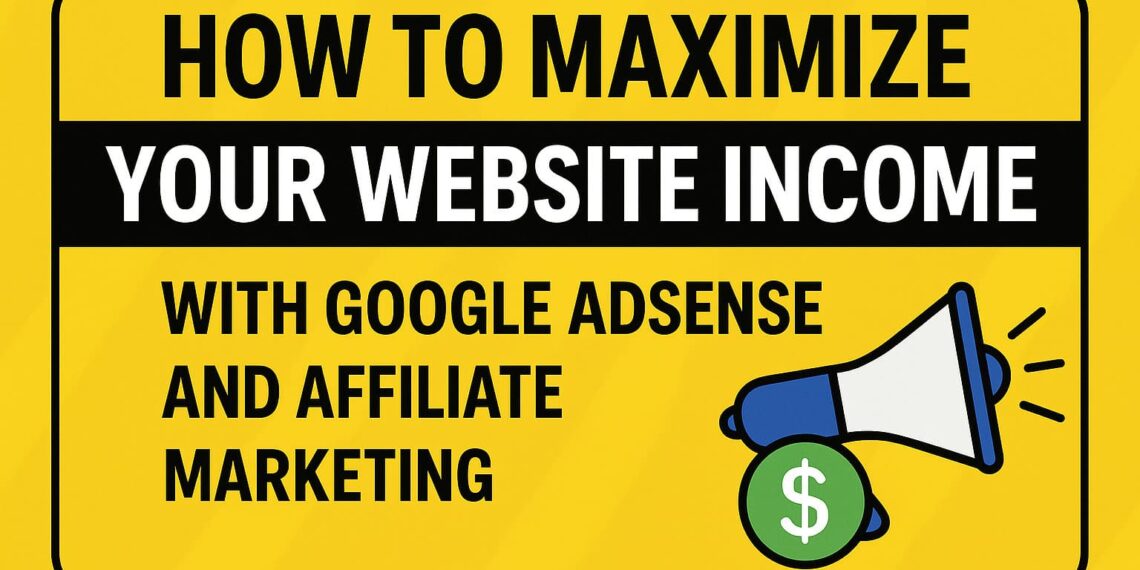How to Maximize Your Website Income with Google AdSense and Affiliate Marketing
If you run a blog or any niche website, you probably know that Google AdSense is one of the simplest ways to earn passive income by displaying ads. But what if you could double or even triple that income by combining AdSense with affiliate marketing?
In this guide, you’ll discover how to use both monetization strategies together the smart way — boosting your revenue while keeping your site clean and compliant.
What is Google AdSense?
Google AdSense is a free advertising program that lets website owners earn money by showing targeted ads. You get paid every time a visitor views or clicks these ads.
Why use AdSense?
- Easy to set up, even for beginners.
- Payments come directly from Google.
- Huge pool of advertisers competing for your ad space, often resulting in higher CPC.
What is Affiliate Marketing?
Affiliate marketing means you promote another company’s products or services on your site. When a visitor clicks your affiliate link and makes a purchase, you earn a commission.
Why add affiliate offers?
- Higher payouts compared to display ads alone.
- Perfect for product reviews, tutorials, and niche content.
- Builds passive income streams from evergreen content.
Why Combine AdSense and Affiliate Marketing?
Many publishers stick to only one monetization model. But smart bloggers know combining both can:
✅ Fill all your page real estate with monetized content.
✅ Earn money from visitors who ignore ads but are ready to buy.
✅ Diversify income, so you’re not fully reliant on just ads or just sales.
Best Practices to Optimize AdSense & Affiliate Together
1️⃣ Pick a Profitable Niche
Certain niches pay more per click and have strong affiliate opportunities. For example:
- Finance: credit cards, loans, insurance.
- Health & Wellness: supplements, fitness programs.
- Tech & Software: SaaS tools, gadgets.
A niche with high CPC and high commissions can significantly boost your total revenue.
2️⃣ Use Smart Ad Placement
Place your AdSense ads where they get seen but don’t annoy your readers:
- Above the fold — near the top of your content.
- In-content ads — within long articles.
- Sidebar or footer — but don’t overdo it.
Test different placements to find the sweet spot for CTR and user experience.
3️⃣ Create Content with Affiliate Intent
Publish content that naturally fits affiliate links, such as:
- “Top 10” product lists.
- Comparison posts (“Product A vs Product B”).
- How-to guides with tool or product recommendations.
Place affiliate links naturally — do not trick readers or violate Google’s policy by making ads look like affiliate links.
4️⃣ Get High-Value Traffic
Organic search traffic converts best. To attract it:
- Target long-tail, buyer-intent keywords.
- Publish original, valuable content.
- Update your articles regularly to maintain rankings.
5️⃣ Track Performance & Tweak
Use Google Analytics and your AdSense dashboard to analyze:
- Which pages get the most clicks?
- Which affiliate offers convert best?
- What traffic sources have the highest CPC?
Regularly test new placements and offers. Double down on what works.
Things to Avoid
🚫 Don’t overload your pages with too many ads or banners.
🚫 Never click your own ads or encourage fake clicks — it will get your AdSense account banned.
🚫 Don’t join shady affiliate programs — stick with trusted brands and networks.
Realistic Case Study: Small Blog Example
Let’s see how this works in practice.
Example:
- You run a fitness blog that gets 20,000 organic visits per month.
- Your average AdSense CPC is $0.50, CTR is 1% — that’s about 200 clicks → $100/month.
- You promote fitness trackers at $80 each, with a 5% commission.
- 5 sales per month = $20 per sale → another $100/month.
- Total: $200/month with room to grow as traffic increases.
Now imagine scaling to 50,000 visits, better ad placement, and high-ticket affiliate offers — earning $500–$1,000 per month is realistic.
Frequently Asked Questions
Q1: Can I use Google AdSense and affiliate marketing together?
A: Yes. Google allows you to run affiliate links on pages with AdSense ads as long as you follow their placement rules.
Q2: Which is better — AdSense or affiliate marketing?
A: They work best together. AdSense gives stable earnings per click, while affiliate marketing can pay high commissions per sale. The right mix depends on your niche and content.
Q3: How much traffic do I need?
A: Even 5,000–10,000 visitors/month can generate $50–$200 with AdSense alone. Add affiliate sales, and you can boost that to $500+ if your audience has buyer intent.
Q4: What affiliate networks should I try?
A: Popular options for beginners: Amazon Associates, ShareASale, CJ Affiliate, Impact, PartnerStack, and ClickBank.
Q5: How do I stay compliant with AdSense?
A: Never click your own ads, don’t buy fake traffic, and don’t place misleading calls to action near your ads or links.
Final Thoughts
Combining Google AdSense with affiliate marketing is a proven way to maximize your website’s revenue potential. Pick the right niche, produce great content, test your placements, and keep an eye on performance. Over time, you’ll build multiple income streams and real online income that grows with your site.
Ready to get started? Start today — and watch your earnings multiply.


